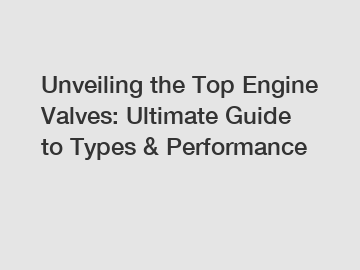Unveiling the Top Engine Valves: Ultimate Guide to Types & Performance
Unveiling the Top Engine Valves: Ultimate Guide to Types & Performance.
Engine valves play a crucial role in the combustion process, regulating the flow of air and fuel into the engine and allowing exhaust gases to exit. Choosing the right type of valve for your engine is essential to maximize performance and ensure optimal efficiency. In this article, we will explore the different types of engine valves available and delve into their performance characteristics, providing you with a comprehensive guide to make an informed decision.
The most common type of engine valves are the poppet valves, which are widely used in both gasoline and diesel engines. These valves have a mushroom-shaped head that rests on a seat and opens and closes by means of a camshaft and valve springs. The two main subtypes of poppet valves are the intake valves and the exhaust valves.

Intake valves are responsible for allowing the fuel-air mixture to enter the combustion chamber. These valves need to provide excellent airflow and atomization to achieve optimal combustion efficiency. Performance intake valves often feature larger heads and stems, allowing for increased air intake and improved overall engine performance.
On the other hand, exhaust valves are responsible for expelling the burned gases produced during the combustion process. Performance exhaust valves are specifically designed to withstand high temperatures and pressure, offering enhanced durability and resistance to deformation. These valves often have improved heat dissipation properties and are made from materials such as stainless steel or alloys.
Another type of engine valve that has gained popularity in recent years is the rotary valve. Unlike the poppet valves, rotary valves use a rotating disc or rotor to control the flow of gases. This design offers several advantages, including a larger flow area, reduced flow resistance, and smoother airflow. Rotary valves are commonly found in high-performance racing engines, where optimizing airflow is critical to achieving maximum power output.
In terms of performance, the choice of engine valves can have a significant impact on horsepower, torque, and overall engine efficiency. Upgrading to high-performance valves can improve airflow, resulting in increased power and better fuel economy. Additionally, performance valves can withstand higher combustion temperatures and pressures, allowing for more aggressive engine tuning.
Moreover, the type of valve material also plays a crucial role in performance. Materials such as titanium or nickel alloys offer higher strength-to-weight ratios, allowing for lighter valves that can operate at higher speeds without compromising durability. This not only contributes to improved engine responsiveness but also helps reduce valve train friction, leading to reduced wear and extended engine lifespan.
In conclusion, understanding the different types of engine valves and their performance characteristics is essential for maximizing engine efficiency and performance. Whether you opt for traditional poppet valves or explore the advantages of rotary valves, selecting the right valve type and material can have a lasting impact on your engine's power output and overall reliability. So, take the time to research and consult with experts to make an informed decision that suits your specific needs and aspirations.
The company is the world’s best high quality engine valve, 2W2622, Engine Valves 12575354 supplier. We are your one-stop shop for all needs. Our staff are highly-specialized and will help you find the product you need.

Comments